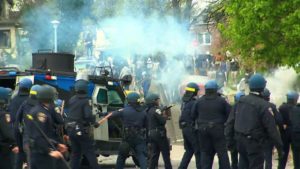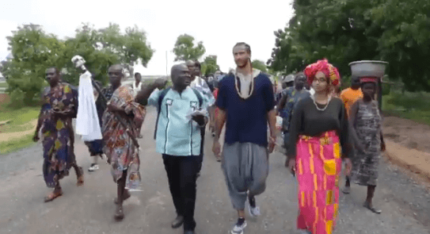
As occurred in cities like Ferguson, the stories quickly morphed from cataloguing the victimization of the Black community at the hands of law enforcement to portraying the frustrated young members of that same community as an evil force of criminals.
It is a tableau that is now beginning to take on the characteristics of a broken record: Community member is killed by police, community explodes in anger, community is attacked for being angry. And the coverage turns from sympathetic reports of peaceful protests to sensationalized dispatches from a war zone—with very little analysis of the roots of the anger.
From the relative comfort of white privilege, it may be hard to understand the nihilistic rage that accompanies Black oppression. Even for those Black people in America who are fairly well off, below the surface there is always a slow simmer of frustration and anger over slights and slams, big and small. For those truly on the margins, there is a visceral desire to disrupt and alarm. To disturb a system whose prosperity requires the suffering and disregarding of poor Black people.
So when “riots” explode in Black communities like Baltimore, it is merely the outward manifestation of American capitalism, the proverbial chicken coming home to roost. If you are going to create the largest wealth and income gap in American history, an economic system that has become noteworthy for its lopsidedness, you must expect periodic explosions. The real question is: Why doesn’t it happen more often?
Across America, every major city with a substantial Black and poor population has all the elements to witness a Ferguson or Baltimore redux: Huge unemployment among young Black males (and females). The disappearance of a working class job base. Crumbling and failing schools. Massive incarceration rates. Visceral and mutual hostility between Black people and the cops. A complete disinterest in the fate of the Black community from the city’s real economic elite. Lack of recreational outlets for young people.
The cities are often run primarily by Black public officials while white capitalists continue to control the purse strings, quietly stashing the city’s real cash outflows garnered from sectors like banking and real estate in their pockets every night and taking them back out to the surrounding wealthy suburbs—or increasingly to cloistered and rich enclaves inside the city lines.
In Baltimore, public officials are using what they have at their disposal: condemning words, threats, law enforcement and the criminal justice system—there have been dozens of arrests since the conflict started. The young people of Baltimore use what they have: destruction of property, fire, looting, rocks. Officials want to call the violence “senseless,” as did incoming Attorney General Loretta Lynch in a statement released yesterday. But if the point is to create chaos and upset the public officials who have failed them, then there is much sense to it.
The responsibility for this chaotic scene will fall into the lap of Baltimore Mayor Stephanie Rawlings-Blake, who will be faulted for not seeing it coming. But any mayor of a struggling Black city knows, deep down, that the elements are always there. That’s why Baltimore had already had in place a curfew for youth 14 and younger, which the mayor announced last night will be extended to everybody in the entire city starting today. The curfew will be in effect for a week, from 10 pm to 5 am, and will be “extended as necessary.”
Even before the killing of Freddie Gray, writer Mike Males noted on the Juvenile Justice Information Exchange that Baltimore’s youth curfew was intended to “gloss over bad conditions officials have failed to redress, such as Baltimore’s campaign to curfew kids playing street football during evenings in poorer neighborhoods devoid of parks and recreation facilities.”
“Safer, inclusive communities welcome more teenagers in public, a reality reflected in the fact that police quickly tire of the hassles and antagonisms curfews entail,” Males wrote. “In short, community leaders who adopt a curfew are admitting there’s something radically wrong with their leadership, not young people.”
A clearly frustrated Rawlings-Blake resorted to name-calling to describe those young people who were burning and looting.
“What we see tonight … is very disturbing,” she said. “It is very clear that there’s a difference between what we saw last week between the peaceful protests … and the thugs, who only want to incite violence and destroy our city.
“I’m a life-long resident of Baltimore. Too many generations have spent their lives building up this city to have it destroyed by thugs, who in a very senseless way are trying to tear down what so many have fought for.”
But her description of a city that has been built up by generations is not at all reflected in the facts of life for much of Baltimore’s Black community, where a quarter of residents are living below the federal poverty line. Researchers Karl Alexander and Linda Olson of Johns Hopkins University traced the lives of nearly 800 poor children in Baltimore for more than 25 years, starting in 1982, and found that almost none of them finished college, Black or white, by 2007. But even without the benefit of a college degree, the 40 percent of the children who were white still wound up having far better outcomes as adults than the Black children. The white men were more likely to be working full-time and to be earning more money.
“Baltimore, like so many other American cities, suffered immensely under the ravages associated with de-industrialization: the loss of industry, population and wealth,” they wrote. “Under such circumstances, many of the city’s disadvantaged youths stumbled along the way. But the consequences have been especially dire for African-Americans. As young adults, African-American men had fared much worse than whites in the job market, even though they and their white counterparts had about the same levels of education and the whites reported higher rates of marijuana and heavy drug use and binge drinking.”
They found that at age 28, nearly half of the white men who had not attended college were employed in the industrial and construction trades, the highest-paying sector of blue-collar employment. But only 15 percent of African-American men worked in these sectors, and even within that small group, annual earnings were less than half that of whites — $21,500 versus $43,000. How did that happen? Because a fifth of the white men who grew up in disadvantaged families had after-school and summer jobs in these industries, which is crucial experience that can help secure a full-time job, while not a single African-American person did.
So it’s very easy to see the racist forces that control their lives, leading to incredible frustration and anger.
In a study of teenagers led by Dr. Kristen Mmari, an assistant professor at Johns Hopkins Department of Population, Family and Reproductive Health, which compared adolescents from impoverished areas in Baltimore, Shanghai, Johannesburg, Ibadan and New Delhi, researchers found that although there were many similarities—in all five cities, adolescents were exposed to unsanitary conditions, substance abuse and violence—teenagers in Baltimore and Johannesburg, despite being located in comparably wealthy countries, had far worse health outcomes and tended to perceive their communities more negatively.
“In Baltimore, which is located in the world’s richest nation per capita and just 40 miles from the White House, adolescents exhibited considerably high rates of mental health issues, substance abuse, sexual risk-taking, sexual violence and teen pregnancy,” the researchers wrote.
One of the biggest differences was that adolescents in Baltimore and Johannesburg had relatively lower levels of “social cohesion,” which refers to the emotional support provided by one’s family and neighbors. In Baltimore, many poor teens grow up in single-parent homes and have a father in prison, while those in Johannesburg tend to lose their parents to AIDS.
“In those cities, kids were much more likely to live in a one-parent household,” Mmari says. (Or, as a youth in Baltimore described it, “The kids are being raised by themselves.”) “Whereas in Delhi, most of these kids are still living in two-parent homes, so they are getting much more support.”
Rep. G.K. Butterfield (D-N.C.), chairman of the Congressional Black Caucus, released a statement yesterday saying that he understands the anger over Freddie Gray’s death. But he said the violence does nothing to ensure that justice is served.
“We understand people are angry and that the community is upset, but violence only distracts us from the justice we seek,” he said. “Violence does not lead to justice.”
But a quest for justice is likely not even the driving force in the minds of most of these young people. They know justice is a distant stranger, one they have rarely seen in their lives. Their most reliable companion is rage. And the death of Freddie Gray has given them a rare opportunity to show it to the world.


